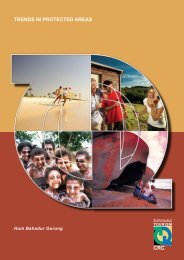icolls - Sustainable Tourism CRC
icolls - Sustainable Tourism CRC
icolls - Sustainable Tourism CRC
Create successful ePaper yourself
Turn your PDF publications into a flip-book with our unique Google optimized e-Paper software.
ECOLOGY, THREATS AND MANAGEMENT OPTIONS FOR SMALL ESTUARIES AND ICOLLS<br />
Chapter 2<br />
MARINE SUBSIDIES SUPPORT ICOLL FOOD WEBS: THE<br />
DEVELOPMENT OF A MARINE PULSE CONCEPT<br />
ICOLLS are abundant and important ecosystems along the Australian coastline. In many regions along the coast,<br />
ICOLLs provide highly sought-after sites for tourism and recreation and the sustainability of ICOLLs in light of<br />
visitor activities has been afforded very little attention. In this component of the project, we aimed to gain a<br />
better understanding of ICOLL ecology and the sustainability of these systems in response to increasing coastal<br />
development, including tourism and recreational demands. Specifically, we used stable isotope signatures of<br />
carbon and nitrogen to examine food web structure and function in small ICOLLs in northern New South Wales,<br />
Australia, with a view to gaining a better understanding of the processes that sustain these systems.<br />
Community composition across the study systems was highly variable, in space and time, reflecting the<br />
strong influence of entrance status on the composition and abundance of taxa. During periods of closure,<br />
ICOLLS support a wide variety of freshwater taxa, which subsequently are lost when connectance with the<br />
ocean is reinstated.<br />
Despite considerable variability in species composition and community structure, all of the sampled ICOLLS<br />
appeared to rely on autochthonous algal production as a major carbon source. During periods of opening, marine<br />
subsidies, in the form of macroalgae and incoming taxa appeared to be important.<br />
Marine subsidies play a strong structuring role in influencing food webs of ICOLLS.<br />
Implications of Catchment Modifications on ICOLL Food Web Structure<br />
and Function<br />
Given their variable physical and chemical characteristics, it comes as no surprise that ICOLLs are biologically<br />
diverse, with species representative of freshwater, estuarine and marine habitats occurring concurrently in many<br />
systems. Similarly, the natural variability in ICOLL opening and closing events may be expected to ensure that<br />
food web structure in these systems is spatially and temporally dynamic. Furthermore, whilst there have been<br />
some studies investigating the ecology and diets of commercially important fish species in ICOLLs, very little is<br />
known of the productivity and trophic dynamics of these ecosystems.<br />
Conceptual Approach to Carbon Flow in ICOLL Food Webs<br />
There is little data on which we can base our understanding of ICOLL food webs. However, given that these<br />
systems are fundamentally distinct from large permanently open estuaries (Pollard 1994a) and are often<br />
characterised by conditions more typical of freshwater creeks, lakes and lagoons, conceptual and theoretical<br />
models derived for freshwater systems might be useful in enhancing our understanding of carbon flow through<br />
these coastal systems.<br />
To date, there have been no models developed to describe the carbon dynamics that support food webs in<br />
ICOLLs. Whilst some models of carbon flow have been derived from research conducted in permanently open<br />
estuaries (e.g. Heymans & Baird 1995; Howarth, Schneider & Swaney 1996; Otero, Culp, Noakes & Hodson<br />
2000), the documented differences between these systems and ICOLLs suggest that their applicability may be<br />
limited. In this study, we decided to build on existing knowledge from riverine ecosystems to describe patterns<br />
and processes in ICOLLs. This application of riverine models to ICOLL ecosystems (and subsequent<br />
development of a novel ICOLL carbon flow model) represents a completely original approach.<br />
Three primary conceptual models have been developed to describe the flow of energy (carbon) in riverine<br />
ecosystems (Figure 1). The River Continuum Concept (RCC) assumes that the relative importance of<br />
allochthonous (terrestrial) carbon sources to stream food webs will diminish progressively from small headwater<br />
streams to large rivers (Vannote, Minshall, Cummins, Seddell & Cushing 1980; Minshall, Cummins, Peterson,<br />
Cushing, Bruns, Seddell & Vannote 1985). The Flood Pulse Concept (FPC) suggests that in large meandering<br />
rivers with extensive floodplains, floods provide consumers with significant pulses of organic matter derived<br />
from the floodplain (Junk, Bayley & Sparks 1989). The Riverine Productivity Model (RPM) assumes that<br />
within-stream production can be a significant source of carbon to consumers in medium to large systems (Thorp<br />
& Delong 1994). Significantly, all of these carbon flow models have been developed to characterise energy flow<br />
14











